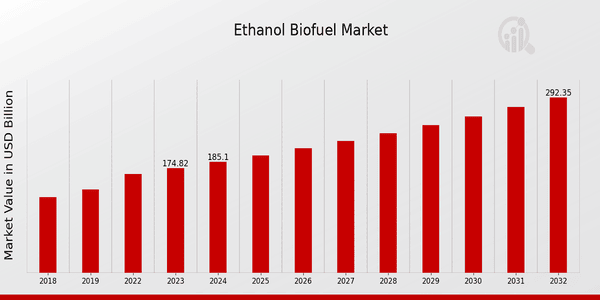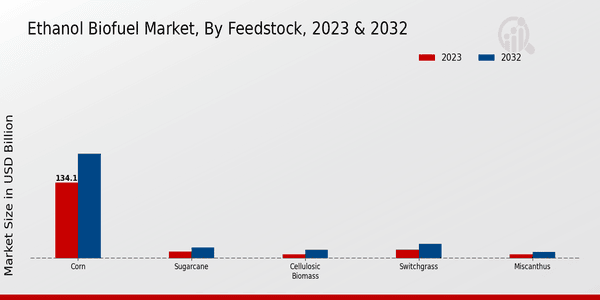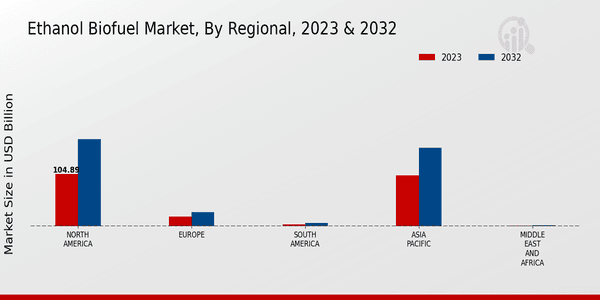Ethanol Biofuel Market Overview:
As per MRFR analysis, the Ethanol Biofuel Market Size was estimated at 165.11 (USD Billion) in 2022. The Ethanol Biofuel Market Industry is expected to grow from 174.82 (USD Billion) in 2023 to 292.5 (USD Billion) by 2032. The Ethanol Biofuel Market CAGR (growth rate) is expected to be around 5.88% during the forecast period (2024 - 2032).
Key Ethanol Biofuel Market Trends Highlighted
There are some changes evolving rapidly in the Ethanol Biofuel Market owing to environmental issues, energy strategies and advancements in technology. A government-backed approach that will encourage the use of renewable energy, as well as the reduction of the use of fossil fuels, an increase in the general quest for green transport, and improvement in technology that will make production processes more efficient and less expensive, are some of the forces driving this market.
There are opportunities in the market to produce second-generation biofuels from feedstocks other than food, such as cellulosic ethanol or ethanol biofuel made from renewable plant-based sources used in aviation fuels to mitigate greenhouse gas emissions. Other changes have been such as the introduction of FFVs that use gasoline mixed with 85 percent ethanol fuels, the establishment of biorefineries for the production of multiple products from biomass feedstocks, and the creation of enhanced blending devices and methods to maintain fuel quality and stability. These trends tell us what the future market for ethanol biofuels will look like, with more emphasis on environmentally sound practices, new technology and the change in the energy matrix worldwide.

Source: Primary Research, Secondary Research, MRFR Database and Analyst Review
Ethanol Biofuel Market Drivers
Rising Environmental Concerns and Government Initiatives
Rising social awareness towards environmental issues and the objective to decrease the emission of greenhouse gases have turned out to be the key driving factors for the growth of the Ethanol Biofuel Market Industry. Multiple countries have taken upon themselves quite a few duties in the form of implementing tough laws aimed at making it easier to install renewable energy sources, including the use of biofuels.
They provide favorable conditions, such as tax exemption and subsidies, directed to the production and consumption of Ethanol biofuel. Additionally, several countries have imposed a blending program, which requires fuel providers to blend a certain percentage of biofuels, such as ethanol, with gasoline or diesel.
These efforts produce a positive market setting for ethanol biofuel and facilitate its growing market.
Increasing Demand for Transportation Fuels
Another important market driver for the Ethanol Biofuel Market Industry is the increasing requirement for transportation fuels. Transportation forms a large chunk of the energy demand worldwide and plays a prominent part in greenhouse gas emissions. Ethanol biofuel has been established as a renewable substitute for fossil fuels and, in many ways, could reduce environmental damage from transportation. It may be incorporated with gasoline or employed as a sole fuel in vehicles designed for the use of ethanol.
The increased use of ethanol biofuel in the transportation sector is encouraged by factors like increasing prices of fuels, energy security risks, and climate change policies.
Advancements in Biofuel Production Technology
The Ethanol Biofuel Market Industry is also benefiting from the advances in biofuel technologies. There has been research and development for efficient and economical processes for the production of ethanol. The establishment of new crops and waste as raw materials is extending the sources for ethanol generation. Also, there are improvements in the yields of ethanol as well as the quality of the fuel as various technologies of fermentation and distillation improve.
Such advances do make it possible for ethanol biofuel to improve and at the same time, be less expensive and more competitive than fossil fuels.
Ethanol Biofuel Market Segment Insights:
Ethanol Biofuel Market Feedstock Insights
The feedstock segment plays a crucial role in the Global Ethanol Biofuel Market, as it determines the raw materials used to produce ethanol biofuel. The choice of feedstock affects various aspects of ethanol production, including cost, sustainability, and environmental impact. Corn has been the dominant feedstock for ethanol production globally, accounting for the majority of production in major markets like the United States and Brazil. Corn is readily available, has a high starch content, and is relatively cost-effective. However, concerns about food security and the environmental impact of corn-based ethanol have led to increased interest in alternative feedstocks.
Sugarcane is another significant feedstock for ethanol production, particularly in regions with favorable growing conditions, such as Brazil and India. Sugarcane has a high sugar content, which makes it an efficient feedstock for ethanol production. However, the use of sugarcane for ethanol can compete with its use for sugar production, potentially impacting the sugar market. Cellulosic biomass, including sources such as switchgrass and miscanthus, represents a promising alternative feedstock for ethanol production. Cellulosic biomass is non-food based and has the potential to provide a more sustainable and environmentally friendly source of ethanol. However, the technology for converting cellulosic biomass into ethanol is still under development and requires further advancements to become commercially viable.
The Ethanol Biofuel Market revenue is projected to reach USD 292.5 billion by 2032, driven by increasing demand for renewable energy sources and government support for biofuels. The feedstock segment is expected to play a critical role in shaping the market growth, with a focus on sustainable and cost-effective feedstock options. In summary, the feedstock segment of the Ethanol Biofuel Market offers a diverse range of options, each with its own advantages and challenges. Corn remains the dominant feedstock, but alternative feedstocks such as sugarcane and cellulosic biomass are gaining attention due to sustainability concerns and technological advancements. The choice of feedstock will continue to influence the cost, sustainability, and environmental impact of ethanol biofuel production, shaping the future of the industry.

Source: Primary Research, Secondary Research, MRFR Database and Analyst Review
Ethanol Biofuel Market Type Insights
The Ethanol Biofuel Market is segmented by Type into Bioethanol, Lignocellulosic Ethanol, and Cellulosic Ethanol. Bioethanol is the most common type of ethanol biofuel and is produced from the fermentation of sugars derived from sugarcane, corn, or other biomass. Lignocellulosic ethanol is produced from the fermentation of cellulose and hemicellulose, which are found in plant biomass. Cellulosic ethanol is a second-generation biofuel that is produced from the fermentation of cellulose, which is found in plant cell walls. The Bioethanol segment is expected to account for the largest share of the Ethanol Biofuel Market in 2023, owing to its wide availability and cost-effectiveness.
The Lignocellulosic Ethanol segment is expected to grow at the highest CAGR during the forecast period due to its potential to be produced from a variety of biomass sources. The Cellulosic Ethanol segment is expected to account for a small share of the market in 2023 but is expected to grow at a significant CAGR during the forecast period due to its potential to be produced from non-food biomass sources.
Ethanol Biofuel Market Application Insights
The Ethanol Biofuel Market is segmented based on application into transportation fuel, industrial fuel, chemical feedstock, and power generation. Among these, the transportation fuel segment accounted for the largest share of the market in 2023 and is expected to continue its dominance throughout the forecast period.
The growth of this segment can be attributed to the increasing demand for ethanol-blended gasoline, which is a cleaner and more sustainable alternative to traditional fossil fuels. The industrial fuel segment is also expected to witness significant growth, owing to the rising demand for ethanol in various industrial applications, such as the production of solvents, paints, and coatings.
The chemical feedstock segment is expected to grow at a steady pace, driven by the increasing use of ethanol in the production of chemicals such as ethylene and polyethylene. The power generation segment is expected to witness moderate growth as ethanol is increasingly being used as a renewable energy source for electricity generation.
Ethanol Biofuel Market Production Capacity Insights
The Ethanol Biofuel Market is segmented by production capacity into small-scale (1-10 million gallons/year), medium-scale (10-100 million gallons/year), and large-scale (over 100 million gallons/year). The large-scale segment is expected to hold the largest share of the market in 2023, accounting for over 60% of the Ethanol Biofuel Market revenue. The medium-scale segment is expected to grow at the highest CAGR during the forecast period, driven by increasing demand for ethanol biofuel from the transportation and industrial sectors. The small-scale segment is expected to account for a smaller share of the market but is expected to witness steady growth due to rising demand for locally produced biofuels.
Ethanol Biofuel Market Sustainability Insights
The sustainability segment of the Ethanol Biofuel Market is gaining traction due to the rising concerns over environmental conservation and the depletion of fossil fuels. Conventional (non-biodegradable) ethanol biofuel, derived from feedstocks such as corn and sugarcane, has faced criticism for its limited sustainability, as it competes with food production and contributes to greenhouse gas emissions during its production process. In contrast, advanced (biodegradable) ethanol biofuel, produced from non-food sources like cellulosic biomass and algae, offers a more sustainable alternative with lower carbon emissions and reduced land-use requirements.
The Ethanol Biofuel Market for advanced biofuel is projected to grow significantly in the coming years, driven by government policies promoting renewable energy and the increasing demand for eco-friendly fuel options.
Ethanol Biofuel Market Regional Insights
The Ethanol Biofuel Market is segmented into North America, Europe, APAC, South America, and MEA. North America is expected to hold the largest market share in 2023, owing to the increasing demand for ethanol biofuel from the transportation sector. Europe is also a significant market for ethanol biofuel and is expected to witness steady growth over the forecast period. The APAC region is expected to be the fastest-growing market for ethanol biofuel due to the increasing demand from the transportation and power generation sectors. South America and MEA are expected to witness moderate growth over the forecast period.

Source: Primary Research, Secondary Research, MRFR Database and Analyst Review
Ethanol Biofuel Market Key Players And Competitive Insights:
Major players in the Ethanol Biofuel Market are constantly striving to gain a competitive edge in the Ethanol Biofuel Market industry. Leading Ethanol Biofuel Market players are focusing on developing innovative technologies, expanding their production capacities, and forming strategic partnerships to strengthen their positions in the market. Ethanol Biofuel Market development activities are primarily centered around enhancing the efficiency of production processes, reducing costs, and improving the overall quality of ethanol biofuel. The Ethanol Biofuel Market Competitive Landscape is characterized by intense competition among established players and emerging entrants.
Archer Daniels Midland Company, a prominent player in the Ethanol Biofuel Market, has a strong global presence with operations in over 190 countries. The company's focus on innovation and sustainability has enabled it to maintain a leading position in the industry. Archer Daniels Midland Company has invested heavily in research and development to enhance its production processes and product offerings. This commitment to innovation has resulted in the development of advanced technologies for producing ethanol biofuel with higher efficiency and lower emissions.
Another leading player in the Ethanol Biofuel Market is Green Plains. The company operates one of the largest ethanol biofuel production facilities in the world. Green Plains has a strong focus on environmental sustainability and has implemented various initiatives to reduce its carbon footprint. The company's commitment to sustainable practices has earned it recognition and partnerships with organizations dedicated to promoting renewable energy. Green Plains continues to expand its operations and invest in new technologies to maintain its position as a key player in the ethanol biofuel industry.
Key Companies in the Ethanol Biofuel Market Include:
- Louis Dreyfus Company
- Valero Energy Corporation
- World Fuel Services Corporation
- Renewable Energy Group, Inc.
- Green Plains Inc.
- Raizen Energia S.A.
- Cargill Incorporated
- COFCO
- Royal Dutch Shell plc
- Archer Daniels Midland Company
- China National Cereals, Oils and Foodstuffs Corporation
- Eni S.p.A.
- Bunge Limited
- Dreyfus Commodities
- Poet LLC
Ethanol Biofuel Market Industry Developments
The Ethanol Biofuel Market is projected to reach USD 292.5 billion by 2032, exhibiting a CAGR of 5.88% during the forecast period. Rising concerns over climate change and the depletion of fossil fuels are driving the demand for sustainable energy sources, including ethanol biofuel. Government initiatives and regulations promoting the use of biofuels are further stimulating market growth.
Recent developments in the industry include: Expansion of production capacity: Major ethanol producers such as Archer Daniels Midland Company and Valero Energy Corporation are investing in expanding their production capacities to meet the growing demand.
Technological advancements: Research and development efforts are focused on improving ethanol production efficiency and reducing its environmental impact. Strategic partnerships: Partnerships between ethanol producers and automobile manufacturers are being formed to promote the adoption of ethanol-powered vehicles.
The increasing adoption of ethanol biofuel in transportation and industrial sectors is expected to drive market growth over the next decade.
Ethanol Biofuel Market Segmentation Insights
-
Ethanol Biofuel Market Feedstock Outlook
- Corn
- Sugarcane
- Cellulosic Biomass
- Switchgrass
- Miscanthus
-
Ethanol Biofuel Market Type Outlook
- Bioethanol
- Lignocellulosic Ethanol
- Cellulosic Ethanol
-
Ethanol Biofuel Market Application Outlook
- Transportation Fuel
- Industrial Fuel
- Chemical Feedstock
- Power Generation
-
Ethanol Biofuel Market Production Capacity Outlook
- Small-scale (1-10 million gallons/year)
- Medium-scale (10-100 million gallons/year)
- Large-scale (over 100 million gallons/year)
- Ethanol Biofuel Market Sustainability Outlook
- Conventional (non-biodegradable)
- Advanced (biodegradable)
-
Ethanol Biofuel Market Regional Outlook
- North America
- Europe
- South America
- Asia Pacific
- Middle East and Africa
| Report Attribute/Metric |
Details |
| Market Size 2022 |
165.11 (USD Billion) |
| Market Size 2023 |
174.82 (USD Billion) |
| Market Size 2032 |
292.5 (USD Billion) |
| Compound Annual Growth Rate (CAGR) |
5.88% (2024 - 2032) |
| Report Coverage |
Revenue Forecast, Competitive Landscape, Growth Factors, and Trends |
| Base Year |
2023 |
| Market Forecast Period |
2024 - 2032 |
| Historical Data |
2019 - 2023 |
| Market Forecast Units |
USD Billion |
| Key Companies Profiled |
Louis Dreyfus Company, Valero Energy Corporation, World Fuel Services Corporation, Renewable Energy Group, Inc., Green Plains Inc., Raizen Energia S.A., Cargill Incorporated, COFCO, Royal Dutch Shell plc, Archer Daniels Midland Company, China National Cereals, Oils and Foodstuffs Corporation, Eni S.p.A., Bunge Limited, Dreyfus Commodities, Poet LLC |
| Segments Covered |
Feedstock, Type, Application, Production Capacity, Sustainability, Regional |
| Key Market Opportunities |
Increasing biofuel blending mandates Growing demand for sustainable fuel Technological advancements in ethanol production Expansion into emerging markets Rising crude oil prices |
| Key Market Dynamics |
Rising demand for renewable fuels Government incentives and mandates Technological advancements Fluctuating feedstock prices Growing environmental concerns. |
| Countries Covered |
North America, Europe, APAC, South America, MEA |
Frequently Asked Questions (FAQ) :
The Ethanol Biofuel Market is expected to reach USD 292.5 billion by 2032, growing at a CAGR of 5.88% from 2024 to 2032.
North America is expected to hold the largest market share in the global ethanol biofuel market, followed by Europe and Asia-Pacific.
The growing demand for renewable fuels, government regulations, and rising environmental concerns are the key factors driving the growth of the global ethanol biofuel market.
Ethanol biofuel is primarily used as a transportation fuel, either as a blend with gasoline or as a standalone fuel in flex-fuel vehicles.
Some of the key competitors in the Ethanol Biofuel Market include Archer Daniels Midland Company, POET, Valero Energy Corporation, and Green Plains Inc.
The Ethanol Biofuel Market is expected to grow at a CAGR of 5.88% from 2024 to 2032.
Some of the challenges faced by the Ethanol Biofuel Market include the availability of feedstock, competition from other renewable fuels, and government policies.
The growing demand for sustainable transportation fuels, technological advancements, and government incentives are some of the opportunities for growth in the global ethanol biofuel market.
The Ethanol Biofuel Market is expected to reach USD 174.82 billion in 2023.
The Ethanol Biofuel Market is expected to reach USD 292.5 billion by 2032.

















